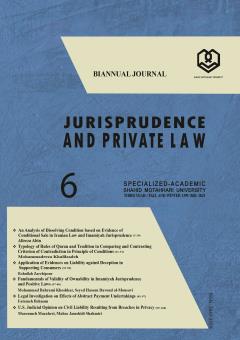-
-
-
Open Access Article
1 - A Study of the Procedures for Liquidating Bankrupt Banks (A Comparative Study of American and Iranian Legal Codes)
Mohammad Isai Tafreshi Khadijeh ShirvaniAbstract: It was after the 1929 Great Recession in the United States that the world economy suffered heavy losses and Iranian officials began paying attention to the bankruptcy of the banks and its highly negative impacts on the national economy. Consequently, the lawma MoreAbstract: It was after the 1929 Great Recession in the United States that the world economy suffered heavy losses and Iranian officials began paying attention to the bankruptcy of the banks and its highly negative impacts on the national economy. Consequently, the lawmakers came to the conclusion that rules and regulations on bankruptcy of the commercial corporations are not sufficient for verifying bankruptcy of the banks – which are considered commercial corporations in kind. On this basis, the United States has tried to consider certain rules and regulations for bankruptcy of banks, thanks to their role in national economy and their differences from the commercial corporations. The bankruptcy code for banks and financial institutions in the United States is called Resolution Regime. It is the government’s legal framework that resolves a failed bank in an orderly way to prevent the collapse of financial markets and the country’s financial system, to continue key services by the banks and to prevent the burden of bankruptcy on the government and taxpayers. In Iranian law, the bankruptcy regime of the banks is not a hundred percent apart from the bankruptcy of the corporations. In case of the bankruptcy of a bank, the Trade Law rules and regulations on bankruptcy will be considered as general rules and other monetary and banking rules and regulations will be particular ones. In case of the silence of the particular laws, the general rules and regulations will be applicable in case of the bankruptcy of the banks. In U.S. law, liquidation is the last step to deal with a bankrupt bank, while in Iranian law - since there is no substitute method for liquidation - the bankrupt bank starts liquidation immediately after receiving the order of bankruptcy. Manuscript profile -
Open Access Article
2 - Legal Investigation on Effects of Abstract Payment Undertakings
Fatemeh BehnamAbstract payment undertaking is a form of unilateral legal act that upon formation creates mandatory undertaking on the issuing party and as far as the issuing party has not paid the certified fund to the beneficiary, he shall have no right vis-à-vis the beneficiary. Co MoreAbstract payment undertaking is a form of unilateral legal act that upon formation creates mandatory undertaking on the issuing party and as far as the issuing party has not paid the certified fund to the beneficiary, he shall have no right vis-à-vis the beneficiary. Commitment to verification of documents, commitment to precision and good faith, commitment to informing the beneficiary about non-conforming cases and commitment to paying issuing party’s undertakings against beneficiary as well as rights resulting from violation of soundness, exactness, genuineness of instruments, and lack of committing fraud on one side, and the rights coming from subrogation in payment on the other side, are among the rights generated after payment of the certified fund by the issuing party with regards to beneficiary. As far as the beneficiary is yet to receive the certified fund, he shall have no undertaking toward the issuing party or the secondary bank. It is clear that after presentation of documents and payment of the fund by the beneficiary, the above-mentioned undertakings shall be attributed to him. Manuscript profile
List of Articles بانک
-
The rights to this website are owned by the Raimag Press Management System.
Copyright © 2017-2024


